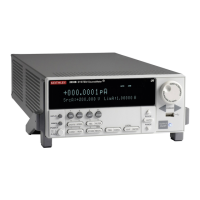2600AS-900-01 Rev. B / September 2008 Return to Section Topics 4-3
Series 2600A System SourceMeter
®
Instruments User’s Manual Section 4: Controlling Multiple Series 2600As (TSP-Link)
Step 3: Reset the TSP-Link
After all the node numbers are set, you must reset (initialize) the TSP-Link interface system. For
initialization to succeed, all units must be powered on when the TSP-Link reset is performed.
Complete the following steps to reset the TSP-Link.
1. From the front panel, press MENU > TSPLINK.
2. Choose Reset.
For remote programming, the following command initializes the TSP-Link:
tsplink.reset()
Step 4: Check the state of the TSP-Link system
The tsplink.state read-only attribute is used to verify that the TSP-Link reset routine was
completed successfully. The returned value
online indicates that the reset was successful for all
instruments (nodes) in the system. The value
offline indicates that the reset has failed.
A few typical reasons for a reset failure include the following:
• Two or more instruments in the system have the same node number.
• There are no other instruments connected to the unit performing the reset.
• One of the units in a properly-connected system is not powered on.
Programming example: After assigning node numbers to the instruments in the system, the
following command checks the state of the TSP-Link:
print(tsplink.state)
If the reset is successful, online will be the output to indicate that communication to all nodes is
established.
How do I use the expanded system?
Accessing resources of TSP-Link nodes
After a successful TSP-Link reset, the node and localnode variables can be used to access
resources of any node in the system.
Using node[N]
The node[N] variable (where N = 1 to 64) is used to send a command to any node in the system.
The node can be the master or a slave. Examples:
node[4].smua.reset() -- Resets SMU A of Node 4.
node[1].smua.reset() -- Resets SMU A of Node 1.
Using the alias (localnode)
The variable localnode is an alias for node[N], where N is the node number of the node
executing the command.
For example, assume that node 1 is the master in a TSP-Link system. To send a command to
node 1, you can use
node[1] or localnode as follows:
-- Resets SMU A of the Master (Node 1).
node[1].smua.reset()
-- Resets SMU A of the Master (Node 1).
localnode.smua.reset()

